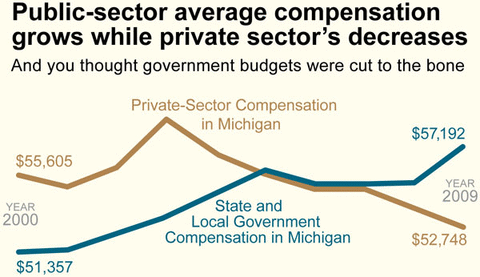Government Unions: The Real Wealth in American Politics
Depending upon which side you were on, the last election was either about "hope and change," or it was about a takeover of the nation by radical progressives. The winners of that last contest are the likely losers of the one coming up this Tuesday, and they are already preparing another storyline to explain what is likely to happen: They say this election is being bought by the wealthy and powerful. They're right, but for precisely the opposite reason from what they mean. The dirty secret of modern American politics is that the real wealthy and powerful are now the public employee unions who will spend more than $175 million on federal campaigns in an effort to literally control who their paymasters will be in Congress.
At risk is a federal spending bonanza that keeps in place pay and benefits for government employees that are out of proportion to the jobs and lifestyles of the private sector workers who pay the taxes in the first place. If they lose control of Congress, government unions are in danger of being forced to live a little more like the rest of us. And Michigan is a major battleground where America's wealthiest political patrons are fighting to stave off defeat.
Public employee pay in this state matched and began to exceed private sector pay back in 2005, according to a recent analysis by the Mackinac Center for Public Policy. That is the year when government workers became the wealthiest class of workers in Michigan, relative to the average taxpayer who pays their salary. During the period 2000-2009, average government worker pay went from being $4,248 less than the private sector to $4,444 more. This is a swing of $8,692 per worker in less than a decade, in favor of our local version of America's most wealthy and powerful political force.
And the situation is perhaps worse when one considers the fringe benefits paid to government workers. According to Mackinac Center analysis, if government benefits were proportional to benefit plans in the private sector, taxpayers in Michigan would save $5.7 billion annually. Thus, Michigan taxpayers, who on average do not have Cadillac benefit plans, are paying an additional $5.7 billion each year so that members of government employee unions can have such benefits.
"We're the big dog," said the head of AFSCME's political operations to the Wall Street Journal last week about the money his union has to spend on politics. "But we don't like to brag."
AFSCME - the American Federation of State, County and Municipal Employees - is also one of the most powerful government employee unions on Earth. What the political director doesn't want to brag about is the Journal's revelation that his union is also the single wealthiest entity on the American political landscape this year. The union's $87.5 million in spending (so far) is $12.5 million above the next closest rival, the U.S. Chamber of Commerce.
But the disparity is even worse than that. When spending directly on candidates, AFSCME gives 99 percent of its money to Democrats. The Chamber, while certainly more friendly to Republicans, still gives 15 percent of its direct candidate cash to Democrats.
And while AFSCME is the biggest, they are far from being the only government union big dog in the yard. There's a whole pack barking loudly this year.
The Service Employees International Union, which is the parent union for many of Michigan's state government employees, is the fourth wealthiest political force in American politics, according to the Journal report. They have already anted up $44 million in spending this campaign season. One-hundred-percent of SEIU cash to federal candidates went to Democrats. (However, in Michigan's state government, the SEIU has also found some Republican friends).
Rounding out the top five richest political forces in America is the National Education Association - America's largest public school employee union - with $40 million. When it gives directly to federal candidates, the NEA gives to Democrats 95 percent of the time.
The NEA's local affiliate, the Michigan Education Association, is also regularly one of the top 5 wealthiest forces in Michigan politics.
The total spending for AFSCME, SEIU and the NEA thus far this year has been $175.5 million. And virtually all of it has been spent directly or indirectly for Democrat candidates. Dividing by the 218 seats necessary for Democrats to control the U.S. House of Representatives, that is more than $805,000 spent per seat - just from these three wealthy and powerful government unions.
Four of the most hotly contested Congressional seats in the nation have been here in Michigan.
The Journal article also makes clear how this political spending impacts the bottom line for these wealthy political power brokers. Hundreds of millions spent before Tuesday helps government unions try to keep hundreds of billions in additional taxpayer dollars flowing freely into their hands.
According to the Journal:
The 2010 election could be pivotal for public-sector unions, whose clout helped shield members from the worst of the economic downturn. In the 2009 stimulus and other legislation, Democratic lawmakers sent more than $160 billion in federal cash to states, aimed in large part at preventing public-sector layoffs. If Republicans running under the banner of limited government win in November, they aren't likely to support extending such aid to states.
Newly elected conservatives will also likely push to clip the political power of public-sector unions. For years, conservatives have argued such unions have an outsize influence in picking the elected officials who are, in effect, their bosses, putting them in a strong position to push for more jobs, and thus more political clout.
Michigan Capitol Confidential is the news source produced by the Mackinac Center for Public Policy. Michigan Capitol Confidential reports with a free-market news perspective.

